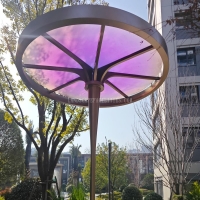Welcome to the website for landscape facilities products and knowledge.
How does the table’s design ensure it remains stable when used near water features?
When selecting outdoor furniture for areas surrounding pools, fountains, or other water features, stability becomes a critical safety consideration. Manufacturers employ several sophisticated design strategies to ensure tables remain securely positioned in these potentially hazardous environments.
The foundation of water-side table stability begins with material selection. Unlike standard outdoor furniture, tables designed for aquatic environments utilize fully waterproof composites and marine-grade aluminum that resist water absorption and structural degradation. These specialized materials maintain their integrity despite constant exposure to moisture, preventing warping or weakening that could compromise stability.
Weight distribution represents another crucial engineering element. Designers intentionally lower the center of gravity through strategically weighted bases, often incorporating wider footplates that create a broader support platform. This design approach significantly reduces tipping potential, even when uneven weight is applied to the table surface. The widened stance creates a mechanical advantage that resists overturning in windy conditions or accidental impacts.
Leg and base configurations receive particular attention in water-adjacent designs. Many manufacturers implement a tripod or quadpod base system with splayed legs that extend beyond the table's perimeter. This configuration creates what engineers call a "stable polygon" - a geometric principle that dramatically increases resistance to tipping from any direction. The legs typically feature non-slip rubber footings with heightened grip coefficients specifically formulated for wet surfaces.
For tables that will see direct water contact, corrosion resistance becomes integral to maintaining long-term stability. Stainless steel components undergo passivation processes that create protective oxide layers, while aluminum elements receive powder coatings that seal surfaces against moisture penetration. These treatments prevent the rust and corrosion that can gradually weaken structural joints and compromise stability over time.
Advanced manufacturing techniques further enhance water-side stability. Water drainage channels integrated into table surfaces prevent water accumulation that could add unstable weight, while concealed fastening systems avoid exposed hardware that might corrode and loosen. Some premium designs even incorporate adjustable leveling feet that compensate for uneven decking or patio surfaces near water features.
The combination of these deliberate design choices results in outdoor tables that maintain exceptional stability in aquatic environments. Through thoughtful material selection, engineered weight distribution, corrosion-resistant construction, and strategic water management features, these tables provide reliable performance and enhanced safety where water and furniture intersect.
Related search:

Recommendation
Metal frame with gradient color acrylic combined with high-end shading landscape facilities